William Davis's Blog: Dr. Davis Infinite Health Blog, page 43
June 17, 2019
What your doctor may not know about cholesterol

Confusion over cholesterol issues is everywhere and shared by most people, including doctors. Unfortunately, it means that, by seeing your primary care doctor or even cardiologist, you are being advised with information that is superficial and largely ineffective while ignoring the MANY issues that really should be addressed to manage risk for cardiovascular disease. Admittedly, these are somewhat complicated issues and even I have been guilty at times of giving overlysimplistic answers. I’ll try to keep this as straightforward as possible, but it is a bit hairy.
I blame this situation on the statin drug industry, as they have painted a misleading picture that, if you take a statin drug or reduce LDL cholesterol, you are absolved of cardiovascular risk. The exaggerated statistical manipulations used by industry—“Lipitor reduces cardiovascular events by 36%” when the real value is, at best, 1%, not to mention the fact that the majority of statin data was paid for by statin manufacturers, a big no-no in any other industry—persuaded practitioners that statins and cholesterol reduction were virtual cures. They are not, of course, as anyone in healthcare who witnesses all the people admitted to the hospital with heart attacks, angina, and sudden cardiac death taking statin drugs will attest. The statin drug industry has therefore caused doctors to wear blinders, rarely looking beyond statins and cholesterol
So what exactly don’t they know about cholesterol? Plenty. For example:
Cholesterol does not occur as free molecules in the bloodstream, as they are fats and would separate from the aqueous plasma. Cholesterol is therefore solubilized by being complexed within lipoprotein particles—fat-carrying proteins—and cell walls. Even if you eat something rich in dietary cholesterol, such as an egg yolk, it does not enter the bloodstream as cholesterol but as complex particles such as chylomicrons created in the intestines or VLDL particles manufactured by the liver.
Lipoproteins—can deliver cholesterol and other components to the walls of arteries such as the coronary or carotid arteries. Whether or not such components contribute to atherosclerosis does not depend on the amount of cholesterol contained within a volume of blood but on the composition of lipoprotein particles, e.g., size, surface conformation, presence of binding proteins, oxidation state, glycation state, electrical charge, etc.
Because up until the mid twentieth century, characterization of the various lipoproteins in the bloodstream was laborious and technically challenging, researchers in the 1950s and 1960s devised a crude workaround: estimate the number of lipoproteins in various fractions of the blood (low-density, very low-density, high-density levels in centrifuged plasma) by measuring a select component. They selected cholesterol, as it was easier to measure. Problem: Using cholesterol as an indirect means of estimating lipoproteins means that you have to assume that everyone shares similar lipoprotein composition, an assumption that is potentially and commonly inaccurate. A crude equation (the Friedewald calculation) was also devised to not measure, but calculate, LDL cholesterol, the focus of most mainstream efforts to reduce cardiovascular risk. LDL cholesterol is calculated from total cholesterol in the entire sample minus the cholesterol in the high-density and very low-density fractions. Once again, assumptions were made to allow this calculation. Cholesterol is therefore a crude marker for the particles that cause atherosclerosis, but that should also not be construed to mean that cholesterol is therefore causal.
When LDL cholesterol, the darling of the pharmaceutical industry and most doctors, is compared to superior measures that actually quantify and characterize lipoproteins (nuclear magnetic resonance, gel electrophoresis, ultracentrifugation), there is a statistical correlation of the two measures in large populations, but poor correlation when applied to an individual. LDL cholesterol, i.e., the cholesterol in the low-density lipoprotein fraction estimated via calculation, also tells you nothing about the number of lipoprotein particles, their size, their surface conf0rmation, their binding characteristics, oxidative state, etc. In other words, LDL cholesterol tells you virtually nothing when applied to a specific individual.
If you cut dietary fat and saturated fat and observe the effects on lipoprotein number and composition, you will witness minor effects, such as a reduction in total LDL particle number but increase in the proportion of small LDL particles, increased VLDL particles, decreased HDL particle number and a shift towards less functional small HDL. Cut grains and sugars and you will witness dramatic transformation of lipoprotein composition and number, effects that handily and dramatically outperform the trivial effects of statin drugs.
Of all the measures on a standard cholesterol or lipid panel, it’s triglycerides that offer the most insight, as triglycerides track the number of very low-density lipoproteins, VLDL, closely. VLDL particles are crucial because they begin the process of transforming large, benign, short-lived LDL particles into small, harmful, oxidation- and glycation-prone, long-lived LDL particles (via a complex process called “heteroexchange” of cholesterol for triglycerides followed by enzymatic “remodeling” of the LDL particle). Where does VLDL come from? Consumption of grains and sugars that fuel liver de novo lipogenesis that converts carbs to triglycerides.
HDL cholesterol, a useful index of overall metabolic health, is reduced by cutting dietary fats, since this increases triglycerides/VLDL that lead to HDL degradation and clearance, and reduced by statins such as Lipitor. HDL is raised, often dramatically, by increasing fat consumption and decreased grain and sugar consumption.
Detailed lipoprotein analyses have been available commercially for over 20 years but are not commonly used, as it requires (as you can appreciate) a deeper understanding of lipoprotein metabolism and do not point towards statins as the solution—they quickly point towards diet and efforts to correct factors such as inflammation and insulin resistance corrected, for example, by losing visceral fat, supplementing vitamin D, and cultivating healthy bowel flora that also contribute substantially to overall health, i.e., all the strategies we put to you in the Wheat Belly Total Health and Undoctored books and programs.
The post What your doctor may not know about cholesterol appeared first on Dr. William Davis.
June 15, 2019
Chorizo, Pepper, and Avocado Skillet
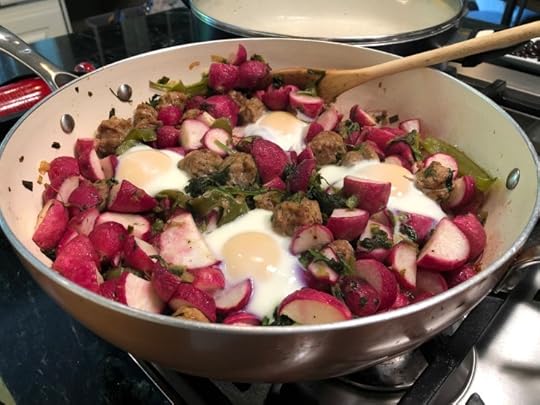
Here’s a recipe from the Wheat Belly 10-Day Grain Detox menu plan that helps you navigate the tricky first 10 days of being wheat/grain-free.
We no longer confine breakfast dishes to breakfast, but have them for lunch or dinner, too. Breakfast skillets are almost always exploding with potatoes, but we don’t want the blood sugar problems of the excessive starch. In this variation of a traditional skillet, we use roasted radishes in place of potatoes. Don’t be turned off by the radishes, as their taste and texture change substantially with roasting, yet they fill out your skillet just like potatoes with none of the problems. While this dish transports and reheats well if you bring it to work or school, if this is too much time and effort to prepare during a busy week, swap this recipe for one of the easier lunch recipes and save this recipe for a weekend lunch when you have more time.
Makes 4 servings
1/4 cup extra-virgin olive oil, divided
1 pound radishes, quartered
½ tsp salt
½ tsp pepper
1 clove garlic, minced
4 green onions, sliced
12 ounces chorizo sausage, sliced
1 green bell pepper, coarsely sliced
2 cups sliced kale or spinach
4 large eggs
1 large avocado, cut in small cubes
Preheat oven to 425º F.
In medium shallow baking pan, combine 2 tablespoons olive oil, radishes, salt, pepper and toss to coat evenly. Place in oven and cook for 20 minutes. Reduce heat to 350º F.
Meanwhile, in a cast iron or other oven-safe skillet over medium-high heat, combine remaining olive oil, garlic, and onions and saute for 2 minutes or until garlic fragrant. Add the sausage and pepper and cook, stirring occasionally, until sausage cooked through. Add kale or spinach, cover and cook until wilted, about 2-3 minutes. When radishes finished baking, stir into kale/spinach mixture.
Make four depressions in the mixture with a large spoon, then crack eggs into each, evenly spaced apart. Bake in oven for 10 minutes or until eggs set.
Remove from oven, add additional sea salt and pepper to taste, and sprinkle avocado cubes over top.
The post Chorizo, Pepper, and Avocado Skillet appeared first on Dr. William Davis.
June 14, 2019
Why wheat makes you fat
“Cut your fat and eat more healthy whole grains” is magnificently effective for causing weight gain. But why?
There are several reasons:
Wheat products, both white and whole grain, are carbohydrate-rich—And the carb is amylopectin A that raises blood sugar and insulin more than table sugar (whole wheat bread has a higher glycemic index than sucrose). Repetitive cycles of high sugar/high insulin promote insulin resistance that, in turn, causes visceral fat to accumulate. The more visceral fat accumulates, the more inflammation develops that adds to insulin resistance and higher insulin levels, a vicious cycle that causes weight gain, since insulin promotes fat storage and suppresses fat mobilization.
Gliadin-derived opioid peptides—Humans lack the digestive enzymes to break down many of the proteins of wheat unlike, say, the proteins in an egg or beef that are broken down into single amino acids. The gliadin protein is therefore broken down into peptide fragments about 4 or 5 amino acids long. These peptide fragments are peculiar in that they cross into the human brain and bind to the brain’s opiate receptors and powerfully stimulate appetite. This phenomenon explains why, for instance, you can be full after eating a bowl of pasta but still feel hungry, reflecting the unnatural, non-physiologic triggering of appetite by wheat.
Inflammation develops for a number of reasons that includes gliadin-provoked intestinal inflammation, gliadin-derived peptides that are also inflammatory, wheat germ agglutinin that both inflames the intestinal lining and other organs when it gains access to the bloodstream. These causes of inflammation further fuel insulin resistance and higher insulin levels.
The amylopectin A of wheat encourages bacteria and fungi to ascend up the gastrointestinal tract and lead to small intestinal bacterial overgrowth, SIBO, and small intestinal fungal overgrowth, SIFO. Once one or both of these conditions become established, it adds enormously to inflammation (via lipopolysaccharide, for instance, due to the dominance of Enterobacteriaceae bacterial species of SIBO) and inflammation, in turn, further worsens insulin resistance.
I believe you can see why I call it a “Wheat Belly,” as wheat is perfectly crafted to cause weight gain, especially in visceral abdominal fat. All the above effects, by the way, also lead to pre-diabetes and type 2 diabetes in parallel with the weight effect.
Turn off this entire panel of unhealthy effects, however, by banishing all wheat—and even better, all grains that share many of the properties of wheat—and you can see weight melt off you. That’s how we do it in the Wheat Belly world, while also adding strategies that help turn off insulin resistance as we do in Wheat Belly Total Health and the Wheat Belly 10-Day Grain Detox.
The post Why wheat makes you fat appeared first on Dr. William Davis.
The dangers of eating low-fat
So much time and energy have been wasted these past 40 or so years in trying to reduce dietary fat, including saturated fat. All you need do is look around you to see the result: the most unhealthy, fattest, most diabetic population in history, prescribed more drugs, more reliant on this (corrupt and unhelpful) thing called modern healthcare, with people in healthcare such as your doctor blaming YOU, rather than themselves and their misguided message. After all, doctors and dietitians are following the dictates of the U.S. Dietary Guidelines for Americans and the USDA food plate that carries the blessings of Big Food and agribusiness.
Cutting dietary fat is not a benign practice—it results in many unhealthy consequences. Cut your fat, cut your saturated fat and:
Other foods need to fill the calorie gap—Step in grain-based foods with their appetite-stimulating, autoimmune-initiating, inflammation-causing, insulin resistance-cultivating, bowel-disruptive effects.
While absurd measures such as total and LDL cholesterol may drop, small LDL particles, VLDL particles, and postprandial (after-meal) lipoproteins reach new highs, effects that lead to heart disease.
Metabolic distortions develop—Insulin increases, blood sugars increase, HbA1c increases, inflammatory measures like C-reactive protein increase.
Insulin resistance develops—The repeated high blood sugars that develop with increased consumption of grains and other carbs cultivates resistance to insulin, the phenomenon that leads to pre-diabetes, type 2 diabetes, visceral fat accumulation, hormonal disruptions, man breasts, hypertension, and increased potential for heart disease, cancers, and dementia.
Fatty liver develops—Because the flood of carbs from the amylopectin A of grains, sugar, and fructose fuel the process of de novo lipogenesis, the conversion of carbs to triglycerides that accumulate in the liver.
Unhealthy changes in bowel flora develop—The increase in carbs/sugars contribute to cultivation of unhealthy species and encourage them to ascend up the small intestine to create small intestinal bacterial and fungal overgrowth.
Despite the misinterpretations and misrepresentations that led to the “cut your fat and saturated fat” message, the most recent evidence tells us that risk for heart disease is not reduced, but is increased by reducing fat. There is no health benefit to reducing dietary fat, only adverse effects. The American Heart Association, the American Diabetes Association, the Academy of Nutrition and Dietetics have all helped propagate this corrupt message even though there was never any real evidence that cutting fat provided health benefits.
If you were to track, for example, lipoprotein levels, metabolic and inflammatory measures such as HbA1c, insulin, glucose, C-reactive protein, and liver enzymes, you would quickly see how destructive low-fat diets can be and how dramatic reversal of all these abnormalities are accomplished by banishing all grains and sugars.
The post The dangers of eating low-fat appeared first on Dr. William Davis.
June 13, 2019
Avocado Bacon Burger
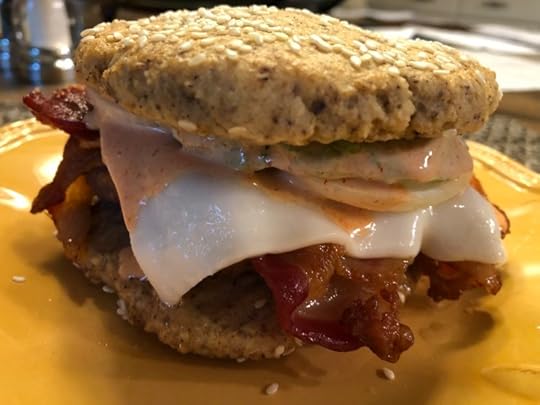
Every once in a while, it’s nice to have a burger filled with plenty of high-fat fillings. I filled mine with sliced avocado, thinly-sliced onion, bacon, sliced goat cheese, and hamburger, topped with my favorite sriracha mayonnaise, but you can choose your own favorite fillings. (Sriracha mayonnaise = 1 part sriracha sauce to 4 parts mayonnaise.)
Unlike conventional burgers, burgers made without grains and with ingredients that are fat-rich make this sort of burger exceptionally filling. I dare you to completely finish just one.
Makes two hamburger buns for one burger
1/2 cup almond flour
1 tablespoon ground psyllium seed
1 egg
1/4 cup water
Dash sea salt
Optional: 1 teaspoon sesame seeds
Preheat oven to 350 degrees F. Line baking sheet with parchment paper.
In medium bowl, combine almond flour, psyllium seed, egg, water, salt and mix thoroughly.
Divide dough into two, flattening to approximately 1/2-inch thickness. Sprinkle with sesame seeds, if desired. Bake for 15 minutes.
Remove from oven and allow too cool. Fill with your choice of ingredients.
The post Avocado Bacon Burger appeared first on Dr. William Davis.
June 12, 2019
Look what Kathy accomplished on the Wheat Belly lifestyle

Kathy provided an update on her Wheat Belly lifestyle that began with the Wheat Belly 10-Day Grain Detox. You may remember Kathy, as she previously shared her story:
The photo at the top is Kathy’s most recent update, looking not only healthier and more slender, but younger.
“2.5 years following the Wheat Belly way of life! Thank you Dr Davis and April Duval for showing me the way! Lost 80 pounds, gained 25 years of health and youth back. Maintaining beautifully.
“The before pic was taken 9 years ago and I wasn’t even at my heaviest at that point. The before pic is the result of decades of low-fat, high carb, ‘healthy’ whole grain poisoning. This way of eating WORKS. Follow the plan 100% to the letter and you will have success.
“I’m 54 years old and feel 24. I’ve slipped here and there but I’m reminded very quickly why I need to stay compliant when I feel like complete crap after eating something non compliant. Soldier on, Wheat Belliers! You can do this!
“I will add that in the before picture, my hair was starting to thin out on the top and the back and it’s growing back now.”
It’s the reversal of inflammation that is responsible for achieving, in effect, age reversal with benefits that go beyond that of just weight loss. 80 pounds lost is nothing to sniff at, of course, but Kathy has achieved so much more than weight loss. This is why the Wheat Belly lifestyle is so powerful.
The post Look what Kathy accomplished on the Wheat Belly lifestyle appeared first on Dr. William Davis.
June 11, 2019
“I’m losing my hair on the Wheat Belly lifestyle!”
It’s a complaint I hear occasionally from people starting the Wheat Belly lifestyle: “I’m losing my hair. Big clumps of hair fall out when I brush!”
Why does this happen? And is it permanent? Will people become bald after a few months?
Take a look at the many before/afters people have posted on the Wheat Belly Facebook page and the photos I’ve posted over the years on the Wheat Belly Blog. Even within the first few days, we commonly witness a curious and dramatic reduction in facial swelling, reduction in around-the-eye puffiness, reversal of skin redness. Many people look quite different. In other words, we see reversal of skin inflammation upon removal of all wheat and grains, since we are removing the several skin inflammation-provoking components such as gliadin, gliadin-derived peptides, wheat germ agglutinin, and the insulinotrophic amylopectin A. Although we see it most clearly on the face, the process of inflammation reversal is body-wide, from head to toe, from mouth to anus, from airway to brain.
Recall that hair is a form of skin and it obviously originates within the skin. When the skin of the scalp experiences reduced inflammation, it sometimes responds with hair loss. So hair loss is an early feature of the response to inflammation reversal that develops in some people. The majority of people who experience this effect find that, after a few months, hair grows back thicker and richer than before.
The only time you need to pursue other causes is if the hair loss proves persistent, an uncommon development. But if you do, consider:
Thyroid dysfunction—If you have added all the components of the Wheat Belly lifestyle, you should have already added iodine. But then consider hypothyroidism, as it is exceptionally common. Have a full thyroid panel run that includes TSH, free T3, free T4, reverse T3, and thyroid antibodies. See the Wheat Belly Total Health, Wheat Belly 10-Day Grain Detox, or Undoctored books for the values we aim to achieve for optimal thyroid status.
Biotin?—While biotin 2 mg per day is often cited as helping hair grow, I have never witnessed any success with this B vitamin. But it is benign and inexpensive.
Boost oxytocin—Unconventional, but boosting oxytocin by consuming our L. reuteri yogurt can occasionally provoke regrowth of thicker hair, in addition to its other spectacular benefits.
Collagen hydrolysates—Combine the oxytocin-boosting L. reuteri yogurt with collagen hydrolysates and you can, over time, enjoy thicker hair (though it will not cause new hair growth). Two tablespoons per day added, for instance, to your coffee makes it easy to incorporate into your daily routine.
Zinc—Zinc is important for skin, and thereby hair, health. If you are not an enthusiastic consumer of animal products (virtually all zinc comes from animal products), then some people respond to zinc supplementation, e.g., 15-20 mg per day.
Consider small intestinal bacterial and/or fungal overgrowth—These advanced topics are issues we pursue in detail in my Undoctored programs. I show you how to identify, confirm, then manage these conditions on your own, since most doctors remain woefully in the dark about these important–and I believe epidemic—health issues. Skin inflammation and rashes are a common manifestation of these disruptions of bowel flora.
Hair loss is a phenomenon shared by all dietary programs that eliminate wheat and grains such as the ketogenic diet, Atkins,’ paleo, etc. I also witnessed hair loss in people in the early Wheat Belly days before I added other strategies such as purposeful efforts to cultivate bowel flora, resulting just with wheat/grain elimination. You might even view hair loss as a positive sign, a sign that you are having a substantial effect in reversing body-wide inflammation.
The post “I’m losing my hair on the Wheat Belly lifestyle!” appeared first on Dr. William Davis.
Announcing the first-ever Dr. William Davis Undoctored Mastermind Sessions
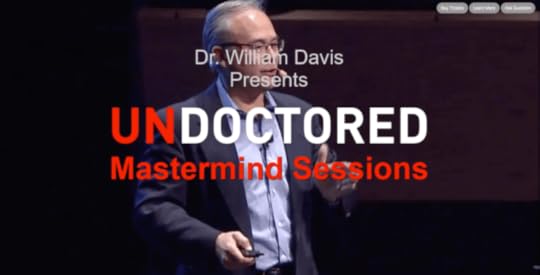
I will be hosting my first-ever Undoctored Mastermind Sessions in August, 2019 here in Milwaukee, Wisconsin.
In these in-depth conversations, I will take a deep-dive into health applying the newest, most cutting-edge concepts to achieve higher levels of daytime functioning, break stubborn weight loss plateaus, increase youthfulness and reverse aging, manage your personal microbiome, and other new and exciting concepts. The conversations will focus on delivering practical, actionable strategies achievable on your own without the interference of doctors or the healthcare system. The program provides a full-day event, including entertainment over a gourmet chef-prepared lunch, concluded with an intimate open wine bar and healthy hors d’oeuvres. If you are a newcomer to the Wheat Belly and Undoctored concepts or would like a refresher course, I will conduct an hour-long pre-event overview to get you started.
There is also an optional pre-event cocktail hour on the evening prior to the main event for anyone wishing to spend more time with our host, Dr. Davis.
The event will be held in the new NO Studios founded by Ridley Scott, Academy award-winning director of 12 Years a Slave. Attendance is limited, so early signup is encouraged. Go here for more information.
The post Announcing the first-ever Dr. William Davis Undoctored Mastermind Sessions appeared first on Dr. William Davis.
Breakfast Nut Mix
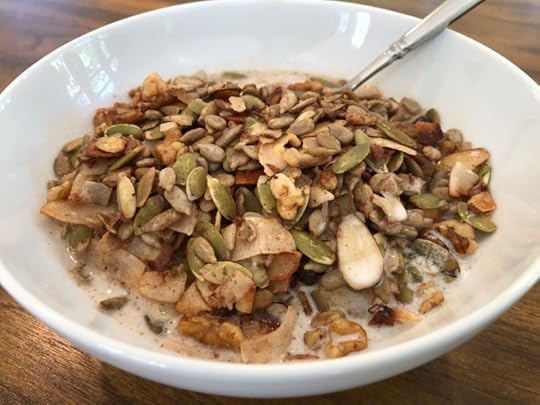
Here a recipe from the Wheat Belly 30-Minute (Or Less!) Cookbook.
Here’s your answer to breakfast cereal—but this “cereal” has none of the problems of the stuff that lines an entire aisle at your supermarket. Serve this nut mix with coconut milk, almond milk, or dairy milk, cold or hot. Top with 1/4 cup fresh or frozen berries. It’s also a great accompaniment to yogurt, such as our oxytocin-boosting L. reuteri yogurt.
I make use of the modest fruit sugar in raisins. If you’re serving the nut mix to your children and they prefer it sweeter, add just a bit of stevia or other benign sweetener. The use of a small quantity of raisins allows you to minimize the use of sweetener.
Makes 9 cups
1/4 cup raisins
1/2 cup coconut milk
2 tablespoons coconut oil, melted
1 teaspoon vanilla extract
1/2 teaspoon almond extract
2 cups raw sunflower seeds
2 cups raw pumpkin seeds
1 cup raw chopped pecans or walnuts
1 cup raw sliced almonds
2 cups unsweetened coconut flakes
Optional: 1 teaspoon ground cinnamon, 1/2 teaspoon ground nutmeg
Preheat oven to 350 degrees F.
In a food chopper or food processor, chop or pulse raisins until reduced to a paste. Place in a small bowl and add coconut milk and oil; mix thoroughly. Add vanilla and almond extracts and stir to combine. Set aside.
In a large bowl, combine the sunflower seeds, pumpkin seeds, pecans, almonds, and coconut. Stir in the reserved raisin mixture until well combined. Stir in cinnamon and nutmeg, if using.
Spread on a large baking sheet and bake for 15 minutes, stirring at least once, or until lightly browned. Remove and allow to cool.
The post Breakfast Nut Mix appeared first on Dr. William Davis.
June 10, 2019
Gluteomorphin: The opiate in your food
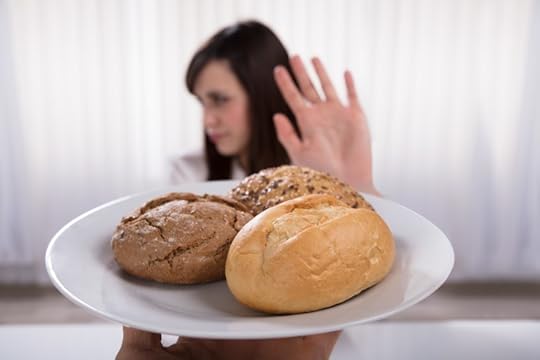
Yes: there are opiates that derive from various food proteins that exert peculiar effects on the human brain. The worst? The opiates that come from the gliadin protein of wheat and related grains.
Opiate receptor researchers at the National Institutes of Health originally coined the term “gluteomorphin” nearly 40 years ago when it was determined that the gliadin protein of wheat undergoes partial digestion (since humans lack the digestive enzymes to fully digest proline-rich amino acid sequences in proteins from seeds of grasses) to yield peptides that are 4- to 5-amino acids long. Some of these peptides were found to bind to the opiate receptors of the brain, thereby exerting opiate-like, or opioid, effects, thus the term gluteomorphin (also sometimes called gliadorphin).
This research was performed in response to several observations made in people with paranoid schizophrenia who, upon removal of all gluten sources (that contain gliadin) experienced a reduction of paranoid thinking and auditory hallucinations. Dr. F. Curtis Dohan, while participating in field research in New Guinea, the Solomon Islands, and Micronesia, also made the observation that non-grain consuming natives of these islands developed an explosive level of schizophrenia when allowed to consume Western foods containing grains. Several subsequent studies were performed linking gliadin-derived opioids with schizophrenic behavior but, as often happens in nutritional research, interest waned, as most psychiatric research focuses on drug treatment. More recently the storm of controversy triggered by the Wheat Belly books have rekindled psychiatric research into the link between schizophrenia and gliadin-derived opioid peptides and there does indeed appear to be an association, at least in a subset of people with schizophrenia.
The current opioid crisis, in which people are prescribed potent opioids like Oxycontin and Dilaudid, become addicted and turn to illicit opioids such as heroin, highlights just how powerful the effects of opioids can be on the human brain. The effects of Oxytocin, of course, differ from the opioid effects of bagels and sandwiches, but there is indeed some concerning overlap. No doubt, susceptibility to the opioid effects of gliadin-derived peptides varies from person to person, but it can range from moderate stimulation of appetite to uncontrolled 24-hour-a-day food obsessions as occurs in binge eating disorder and bulimia. Or it can involve behavioral outbursts and deterioration of attention span in children with autistic spectrum disorder or attention deficit hyperactivity disorder (ADHD). Or it can be depression and suicide (at least as suggested by several observational studies such as this one). And, as with stopping prescription and illicit opioids, halting all consumption of gliadin sources yields an opioid withdrawal syndrome, effects readily mimicked by administering an opiate-blocking drug such as naloxone or naltrexone.
Interestingly, recent evidence points towards some species of Bifidobacteria in the gastrointestinal tract as being able to degrade gliadin-derived opioid peptides. This suggests that at least some of the modern phenomenon of wheat intolerance and the mind effects of gliadin-derived opioids may be due to dysbiosis/small intestinal bacterial overgrowth so prevalent among people nowadays. But, as always, don’t misinterpret this to mean that, if healthy bowel flora is restored, wheat must now become something good for you—there’s still too many other unhealthy components to contend with.
Bottom line: That innocent muffin or bag of pretzels yield opioids that have peculiar effects on your brain, emotions, and behavior with results that depend on your individual susceptibility. The result might be depression, it might be appetite stimulation. Unlike having to take an antidepressant, sedative, or antipsychotic, however, just not eating wheat and related grains can represent cure of this particular opioid crisis.
The post Gluteomorphin: The opiate in your food appeared first on Dr. William Davis.
Dr. Davis Infinite Health Blog
Recognize that this i The insights and strategies you can learn about in Dr. Davis' Infinite Health Blog are those that you can put to work to regain magnificent health, slenderness, and youthfulness.
Recognize that this is NOT what your doctor or the healthcare system provides, as they are mostly interested in dispensing pharmaceuticals and procedures to generate revenues. The healthcare INDUSTRY is not concerned with health--you must therefore take the reins yourself.
Dr. Davis focuses on:
--Real, powerful nutritional strategies
--Addresing nutrient deficiencies unique to modern lifestyles
--Deep insights into rebuilding the microbiome disrupted by so many modern factors
Follow Dr. Davis here and on social media and you can witness the extraordinary successes people enjoy on his programs. ...more
- William Davis's profile
- 159 followers



